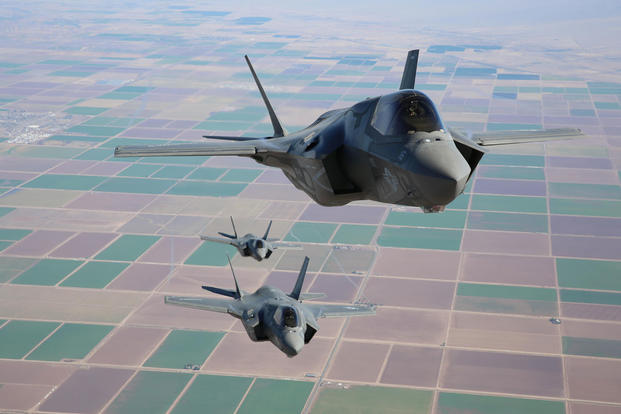Funding for the Marine Corps' new F-35 Joint Strike Fighter and the F/A-18 Hornet will get a boost next year, Defense Secretary Ash Carter told troops this week.
During a visit on Wednesday to Marine Corps Air Station Miramar, California, coming a week before the release of the Pentagon's proposed fiscal 2017 budget, Carter told Marines that maintaining readiness in aviation for the Corps was a top priority.
"You are kind of the beating heart of readiness for the Marine Corps and so you see everything that is involved in keeping high readiness, crew proficiency, airframe availability," he said. "And in that connection, airframe availability and just generally maintenance and readiness overall, particularly in Marine aviation, that's an area where we're making investments in this year's budget."
Those investments include an acceleration in the pace at which the Navy and Marine Corps purchase their variants of the F-35 Joint Strike Fighter, Carter said. The Marines' variant of the aircraft, the F-35B, became the first to reach initial operational capability last July.
"That's a spectacular aircraft and an enormous amount of work went into making that aircraft successful," Carter said. "And there were times when, you know, it took really a great deal of work on the part of everyone, but there it is and there it is at IOC."
Separately, Marine Corps Commandant Gen. Robert Neller on Thursday reaffirmed plans to deploy a first squadron of the fighters to Iwakuni, Japan, next January.
Carter did not specify how much the F-35 buy is expected to grow for the Marine Corps and Navy.
His remarks, however, signaled continued faith in the program despite the recent release of a Pentagon report that found the aircraft continues to battle technical glitches and mechanical deficiencies.
Carter also said the new budget request would include money for depot maintenance for the Hornet, a fighter jet that has been flying for the Marine Corps since 1984. He acknowledged there was a maintenance backlog that needed to be addressed with the airframe.
In September 2015, the Marines' deputy commandant for aviation, Marine Lt. Gen. Jon Davis was even more direct, saying years of funding shortfalls had left the Marine Corps at 19 percent below a minimum acceptable number of operational F/A-18s.
"Some of you know who work with F-18s, the -- particularly for the older models that we've worked extremely hard, they're more challenged in the maintenance sense than we had anticipated," Carter said. "We're going to fund that [maintenance]."
Finally, the secretary said, the budget request would provide funding to tailor the Marines' combined arms training at Marine Corps Air Ground Combat Center 29 Palms -- the backbone of its training workup -- to a greater number of global missions in the post-Afghanistan era.
The Marines' Integrated Training Exercise, or ITX, at 29 Palms has been a pre-deployment mainstay since 2012, when it replaced the Combined Arms Exercise, also known as CAX or Mojave Viper. Marine Corps brass have talked about building a more tailored pre-deployment training package but have yet to debut a formal new program.
Carter called a renewed emphasis on combined arms training important in the same ways that equipment maintenance was for the Marine Corps.
"It's important to get back to that because we spent many years of necessity training specifically mostly for [counterinsurgency], right, and because of Iraq and Afghanistan," Carter said. "Now we're making the transition to a wider spectrum of needs, and so we need you and the Marine Corps, generally, to be trained to that wider spectrum and that requires combined arms training."
The full budget request is expected to be released at the Pentagon on Tuesday.
-- Hope Hodge Seck can be reached at hope.seck@monster.com. Follow her on Twitter at @HopeSeck.
Related Video:
Bullet Points: F35 Lightning II





























